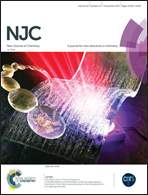Study of curcumin antioxidant activities in robust oil–water nanoemulsions†
Abstract
Oil-in-water (o/w) nanoemulsions of peanut, linseed and mustard oils with sodium dodecyl sulphate (SDS), dodecyltrimethylammonium bromide (DTAB), tween 20 (Tw-20) and tween-40 (Tw-40), were prepared for catalysing the antioxidant activity of curcumin. The peanut oil–Tw-20, linseed oil–DTAB and mustard oil–SDS ranging in size from 488.41 to 1337.09 nm, 446.10 to 1124.00 nm and 27.37 to 62.05 nm, have expressed free radical scavenging activities (FRSA) of 72.38 to 93.13 %DPPH, 65.08 to 85.55 %DPPH and 62.15 to 89.44 %DPPH, respectively. Their surface tensions in the range of 41.68–58.77 mN m−1 and viscosities of 0.8051–1.4059 mPa s infer enhanced curcumin dispersion. FTIR stretching frequencies (SF) of 1500–2000 cm−1 (![[double bond splayed left]](https://www.rsc.org/images/entities/char_e009.gif) C
C![[double bond, length as m-dash]](https://www.rsc.org/images/entities/char_e001.gif) O) and 3500 cm−1 (–OH) infer curcumin encapsulation with the disappearance of the oil–curcumin SF (500–1300 cm−1). Friccohesity, a distribution indicator exercised via cohesive forces (CFs) and intermolecular forces (IMFs), has depicted curcumin nanodispersion on weakened oil and curcumin CFs.
O) and 3500 cm−1 (–OH) infer curcumin encapsulation with the disappearance of the oil–curcumin SF (500–1300 cm−1). Friccohesity, a distribution indicator exercised via cohesive forces (CFs) and intermolecular forces (IMFs), has depicted curcumin nanodispersion on weakened oil and curcumin CFs.



 Please wait while we load your content...
Please wait while we load your content...